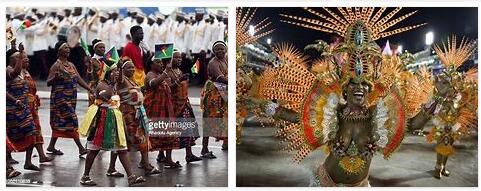
Culture
Peoples and cultures
With the exception of the Pygmies, almost all Equatorial Guineans are Bantu. Under this name -which would be the plural of mu-ntu (man) – some sixty million individuals who live in Central, Eastern and Southern Africa are grouped.
Among these Bantu peoples, one must take into account:
The Fang (72% of the population, in the Continental Region): Largely majority in Equatorial Guinea. According to legend, it is the first Fang who gave the continent its name: Africa would in effect be a deformation of Afiri Cara, the name of a distant mythical ancestor of the Fang. Fang society is structured into relatively autonomous families, clans, and tribes. From the paternal line, the offspring are transmitted by men, hence the importance of the father, the uncle and the first-born. The art of the Fang is particularly appreciated in the world and the wooden sculptures, masks and their ritual statues inspired the Cubists and numerous 20th century painters such as Picasso or Matisse..
The Bubi (15% of the population): They live essentially on the island of Bioko. They are surely the first occupants of the island. Probably originally from Cameroon, the Bubi are Bantu belonging to the “yam civilization” that developed in prehistoric times in the Lake Chad basin. Bubi society was structured in the form of a kingdom before the arrival of Europeans and this kingdom remained until the end of the colonial period. Its original religion was of a monotheistic type with numerous spirits, and the island of Bioko is strewn with places of a religious nature: Pico Basilé, volcanic lakes, caves, etc. Traditional dance, music and song, largely inspired by the religious ceremonies of the Bubi, are still deeply rooted, despite the impact of Catholicism.
The Ndowé: A minority people, they probably came to Río Muni with the Fang in the 12th and 13th centuries. They occupied the coast, which earned them the name of “beachgoers”: those on the beach. Many ethnic groups are part of the Ndowé: the Kombe, the Bujeba, the Bapuku, the Balenke, the Enviko and the Benga. The social organization of the Ndowé is similar to that of the Fang and is hierarchical in families, towns, lineages and clans.
The Bisio or Bujeba: Originally from Cameroon, they are few in number and emigrated in the 19th century to the nearby coastal regions of the continental region, via the Ntem River.
The Fernandinos and The Criollos: They are the mestizo descendants of Liberians and Sierra Leonese who came over the centuries to work on the plantations on the island of Bioko. They quickly formed an important bourgeoisie of landowners and merchants that lived for a long time in the capital.
The Pygmies: They are considered the first residents of Africa. They live in small groups in the equatorial jungle, in temporary camps of thirty to fifty people. The villages are made up of circular huts built with leaves around a fire in the middle of a clearing. In Equatorial Guinea, they are called Beyele and Bokuign. They are essentially dedicated to hunting and gathering roots, wild berries, honey and worms, since they still do not know agriculture, pottery and metallurgy.
Languages
According to educationvv, Spanish is the official administrative and teaching language. French (since 1998, spoken by many Equatoguineans, is currently the second official language and facilitates communication with neighboring countries of the sub-region, especially within the framework of the CEMAC (Central African Economic and Monetary Community) and Portuguese (since 2007, to obtain the absolute membership of the Community of Portuguese Language Countries.) Almost all the populations Fang (in the continental region called Rio Muni), Bubi (in Bioko), Ndowe, Bisio speak languages closely related to each other, called Bantu languages This family of languages has more than 400 dialects that all derive from the same ancestral language called pro-Bantu.
Religion
Today, 90% of Equatorial Guineans practice the Catholic religion. Christianity was first introduced through the English Protestant missions but Catholicism became the official religion during the Spanish colonization. Its influence is still very great. Other Christian religions are also professed (6.8%), religions of the ancient residents such as animism (9.1%) and there is an Islamic minority (4%).
Health
In December 2003, the Ministry of Health recognized the existence in the country of 15,000 people affected by AIDS, with a higher incidence among young people, who represent 80% of the total. In 2005 the number of affected had risen to 30,450.
Vaccination
To enter the country, the yellow fever vaccine is required. In Spain, vaccines can be made at the Foreign Health delegations, at the International Vaccination Centers. Yellow fever: A yellow fever vaccination certificate is required for all travelers coming from infected areas. For travelers arriving from non-endemic areas, vaccination and prophylactic measures are recommended. Cholera: Vaccination is not mandatory but cholera is a serious risk in this country and precautions are essential. Malaria: The risk of malaria, predominantly in malignant falciparumform, exists throughout the year throughout the country. It is recommended to boil and sterilize the water before drinking it. Milk must also be boiled. The fruit should preferably be eaten peeled.